Poole Ch.P., Jr. Handbook of Superconductivity
Подождите немного. Документ загружается.

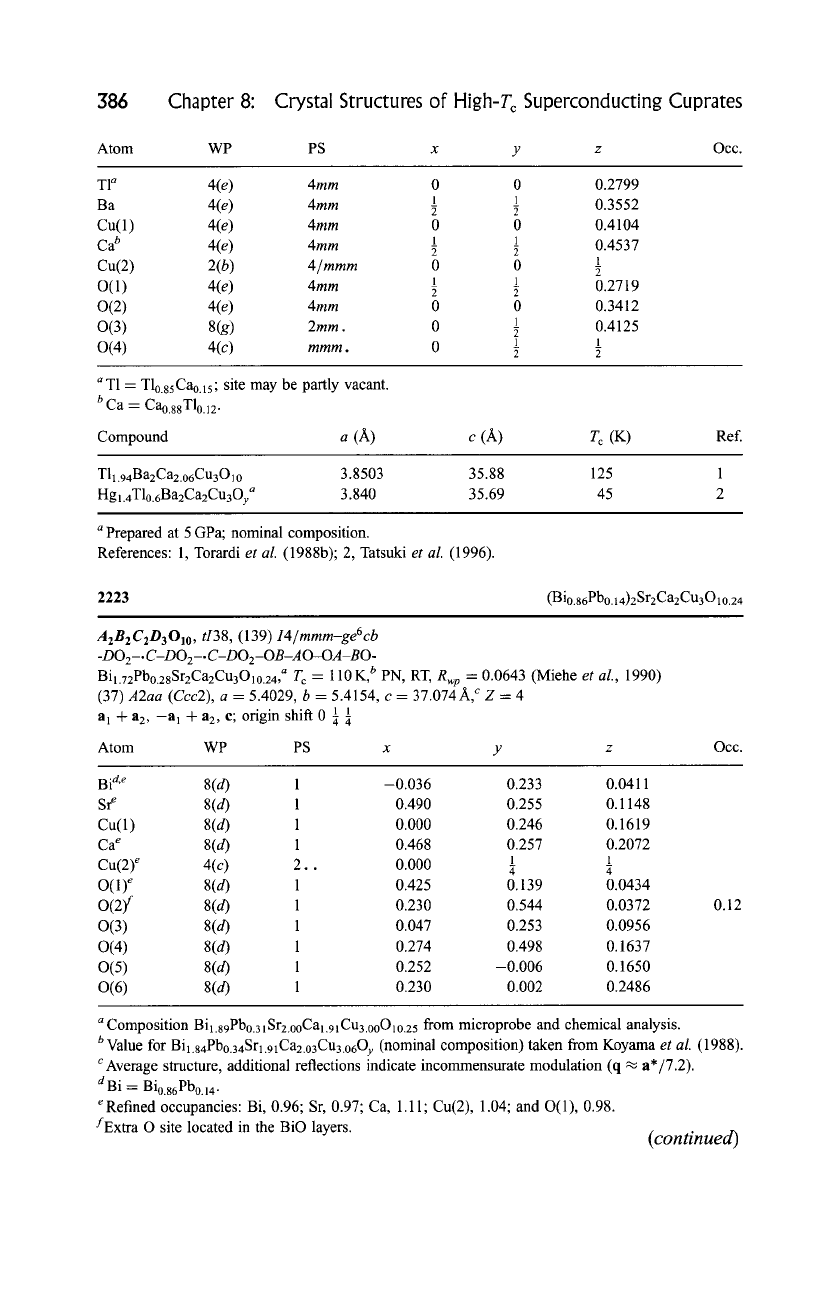
386
Chapter 8: Crystal Structures of High-T~ Superconducting Cuprates
Atom WP PS x y z Occ.
T1 a 4(e)
4mm
0 0 0.2799
1 1
0.3552
Ba 4(e)
4mm ~
Cu(1 ) 4(e)
4mm
0 0 0.4104
1 1
0.4537
Ca b 4(e)
4mm ~
1
Cu(2) 2(b)
4/mmm 0 0
1 1
0.2719
O(1) 4(e)
4mm ~
0(2) 4(e)
4mm
0 0 0.3412
1 0.4125
0(3) 8(g)
2mm . 0
1 1
0(4) 4(c)
mmm . 0 ~
aT1 = Tlo.85Cao.15; site may be partly vacant.
b Ca = Cao.88Tlo.12.
Compound a (A) c (A) T c (K) Ref.
T11.94Ba2Ca2.o6Cu301 o 3.8503 3 5.88 125
Hg 1.4Tlo.6B a2Ca2Cu30y a 3.840 35.69 45
a
Prepared at 5 GPa; nominal composition.
References: 1, Torardi
et al.
(1988b); 2, Tatsuki
et al.
(1996).
2223
(Bio.86Pbo. 14)2Sr2Ca2Cu3010.24
A2B2C2D301o , ti38,
(139)
I4/mmm-ge6cb
-DO2-.
C-D02-. C-DO 2-OB-A O-OA-BO-
Bil.72Pbo.28Sr2Ca2Cu301o.24, a T c -- 110 K, b PN, RT,
Rwp
= 0.0643 (Miehe
et al.,
1990)
(37)
A2aa (Ccc2),
a -- 5.4029, b = 5.4154, c = 37.074A, c Z = 4
al + a2, -al + a2, c; origin shift 0 1 1
Atom WP PS x y z
Occ.
Bi ax 8(d) 1 -0.036 0.233 0.0411
Sr e 8(d) 1 0.490 0.255 0.1148
Cu(1) 8(d) 1 0.000 0.246 0.1619
Ca ~ 8(d) 1 0.468 0.257 0.2072
1 1
Cu(2) e 4(c) 2.. 0.000 ~
O(1) e 8(d) 1 0.425 0.139 0.0434
O(2) f 8(d) 1 0.230 0.544 0.0372
0(3) 8(d) 1 0.047 0.253 0.0956
0(4) 8(d) 1 0.274 0.498 0.1637
0(5) 8(d) 1 0.252 -0.006 0.1650
0(6) 8(d) 1 0.230 0.002 0.2486
0.12
a
Composition Bil.89Pbo.31Sr2.ooCal.91Cu3.ooOlo.25 from microprobe and chemical analysis.
b Value for Bil.84Pbo.34Srl.91Ca2.o3Cu3.o6Oy (nominal composition) taken from Koyama
et al.
(1988).
c Average structure, additional reflections indicate incommensurate modulation (q ~ a*/7.2).
d Bi = Bio.86Pbo.14.
eRefined occupancies: Bi, 0.96; Sr, 0.97; Ca, 1.11; Cu(2), 1.04; and O(1), 0.98.
fExtra O site located in the BiO layers.
(continued)
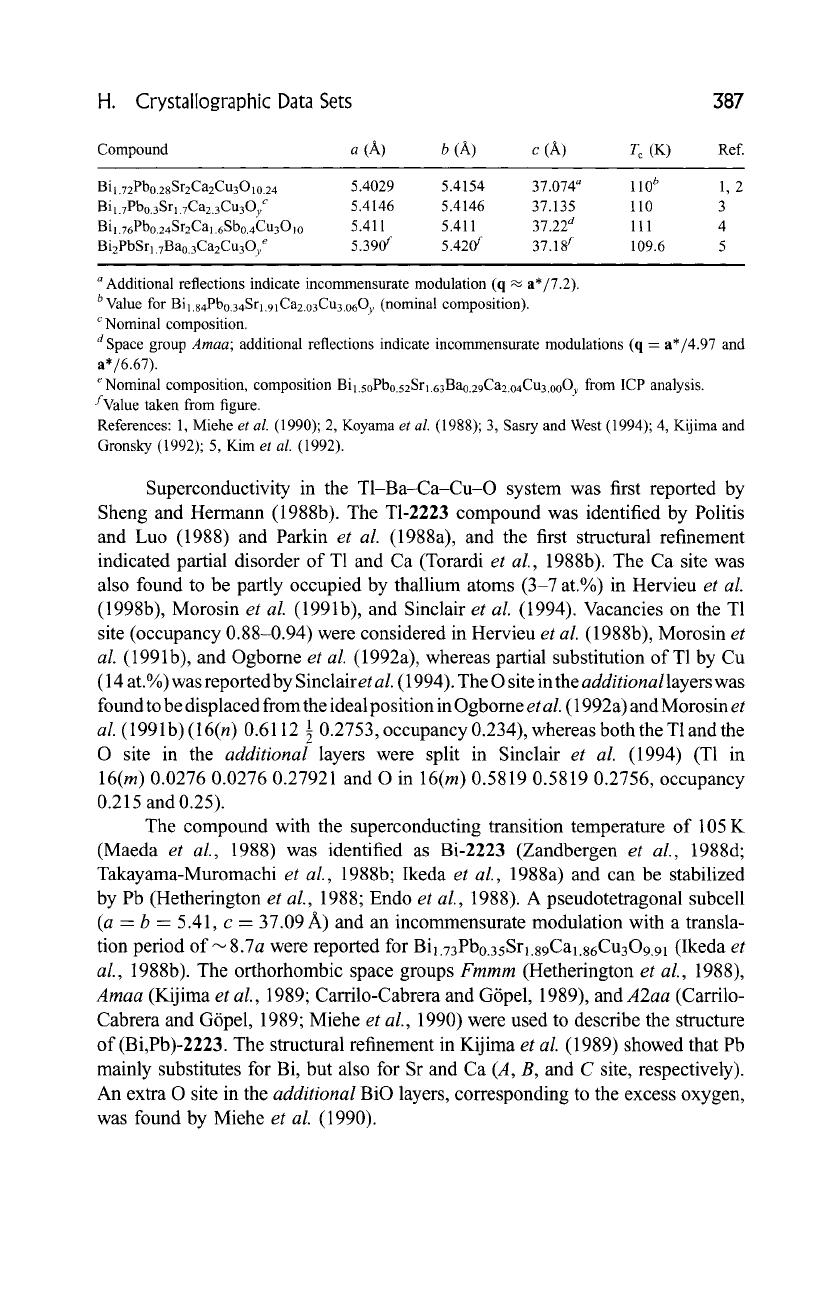
H. Crystallographic Data Sets 387
Compound
a (A) b (A) c (A) T c (K) Ref.
Bi 1.72Pb0.28 Sr2Ca2Cu30 10.24
Bil.7Pbo.3Srl.7Ca2.3Cu3Oy c
B i 1.76Pb0.24 Sr2 Ca 1.6Sbo.4Cu3010
Bi2PbSrl.7Bao.3Ca2Cu3Oy e
5.4029 5.4154 37.074 a 1 l0 b 1, 2
5.4146 5.4146 37.135 110 3
5.411 5.411 37.22 d 111 4
5.390 r 5.420 r 37.18 f 109.6 5
a
Additional reflections indicate incommensurate modulation (q ~ a*/7.2).
b Value for Bil.s4Pbo.34Srl.91Ca2.o3Cu3.o6Oy (nominal composition).
c Nominal composition.
d Space group
Amaa;
additional reflections indicate incommensurate modulations (q--a*/4.97 and
a*/6.67).
eNominal composition, composition
Bil.5oPbo.52Srl.63Bao.29Ca2.o4Cu3.ooOy
from ICP analysis.
fValue taken from figure.
References: 1, Miehe
et al.
(1990); 2, Koyama
et al.
(1988); 3, Sasry and West (1994); 4, Kijima and
Gronsky (1992); 5, Kim
et al.
(1992).
Superconductivity in the T1-Ba-Ca-Cu-O system was first reported by
Sheng and Hermann (1988b). The T1-2223 compound was identified by Politis
and Luo (1988) and Parkin
et al.
(1988a), and the first structural refinement
indicated partial disorder of T1 and Ca (Torardi
et al.,
1988b). The Ca site was
also found to be partly occupied by thallium atoms (3-7 at.%) in Hervieu
et al.
(1998b), Morosin
et al.
(199 lb), and Sinclair
et al.
(1994). Vacancies on the T1
site (occupancy 0.88-0.94) were considered in Hervieu
et al.
(1988b), Morosin
et
al. (1991
b), and Ogbome
et al.
(1992a), whereas partial substitution of T1 by Cu
(14 at.%) was reported by Sinclair
et al.
(1994). The O site in the
additional
layers was
found to be displaced from the ideal position in Ogbome
et al.
(1992a) and Morosin
et
al.
(1991 b) (16(n) 0.6112 89 0.2753, occupancy 0.234), whereas both the T1 and the
O site in the
additional
layers were split in Sinclair
et al.
(1994) (T1 in
16(m) 0.0276 0.0276 0.27921 and O in 16(m) 0.5819 0.5819 0.2756, occupancy
0.215 and 0.25).
The compound with the superconducting transition temperature of 105 K
(Maeda
et al.,
1988) was identified as Bi-2223 (Zandbergen
et al.,
1988d;
Takayama-Muromachi
et al.,
1988b; Ikeda
et al.,
1988a) and can be stabilized
by Pb (Hetherington
et al.,
1988; Endo
et al.,
1988). A pseudotetragonal subcell
(a = b -- 5.41, c = 37.09 A) and an incommensurate modulation with a transla-
tion period of~ 8.7a were reported for Bil.73Pbo.35Srl.89Cal.86Cu309.91 (Ikeda
et
al.,
1988b). The orthorhombic space groups
Fmmm
(Hetherington
et al.,
1988),
Amaa
(Kijima
et al.,
1989; Carrilo-Cabrera and G6pel, 1989), and
A2aa
(Carrilo-
Cabrera and G6pel, 1989; Miehe
et al.,
1990) were used to describe the structure
of (Bi,Pb)-2223. The structural refinement in Kijima
et al.
(1989) showed that Pb
mainly substitutes for Bi, but also for Sr and Ca (A, B, and C site, respectively).
An extra O site in the
additional
BiO layers, corresponding to the excess oxygen,
was found by Miehe
et aL (1990).
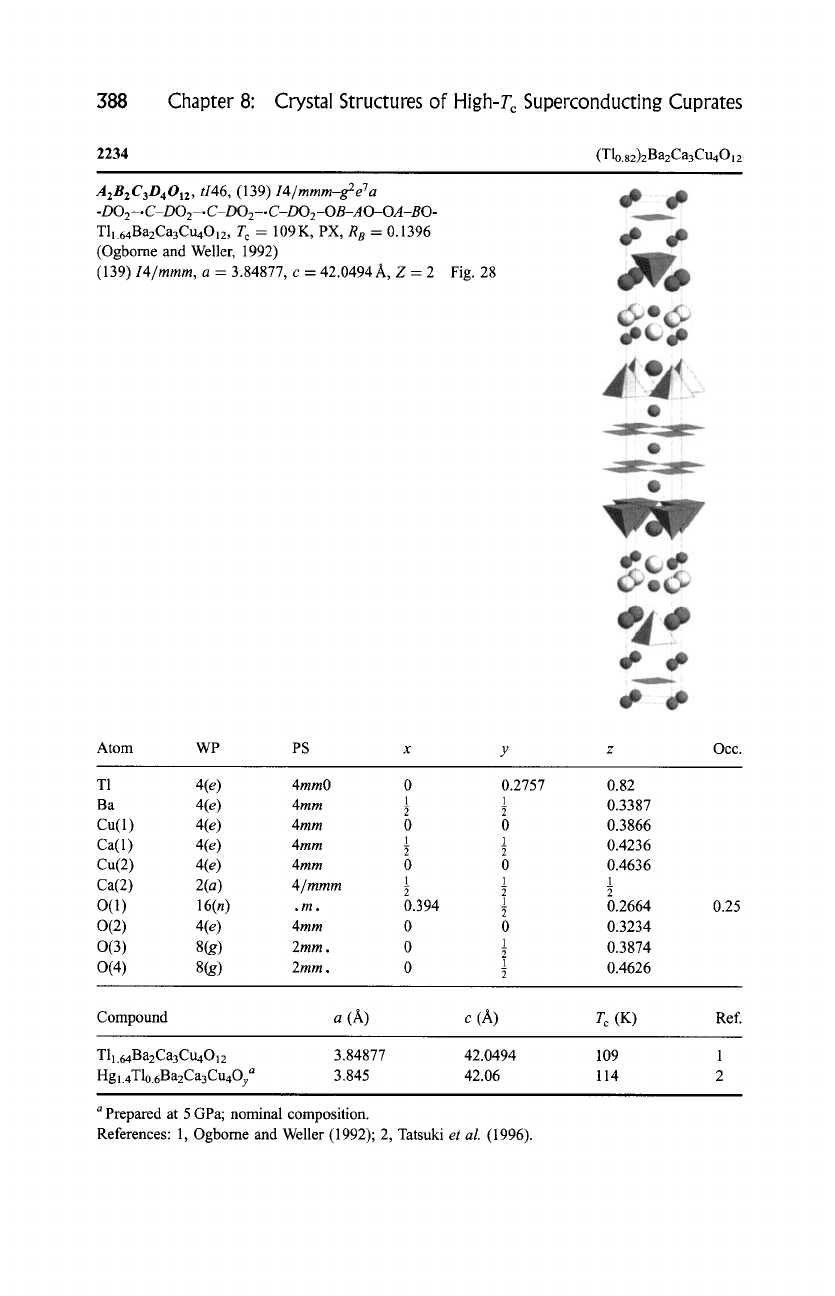
388 Chapter 8:
2234
Crystal Structures of High-T~ Superconducting Cuprates
(Tlo.82)2Ba2Ca3Cu4012
A2B2C3D4012,
ti46, (139)
14/mmm-g2e 7 a
-DO2-.C-DO2-.C-DOz-.C-DO2-OB-AO-OA-BO-
Tll.64Ba2Ca3Cu4O12, T c --- 109K, PX, R e --0.1396
(Ogborne and Weller, 1992)
(139)
I4/mmm,
a = 3.84877, c = 42.0494A, Z = 2 Fig. 28
Atom WP PS x
z Occ.
T1 4(e)
4mmO 0
1
Ba 4(e)
4mm
Cu(1) 4(e)
4mm 0
1
Ca(l) 4(e)
4mm
Cu(2) 4(e)
4mm 0
1
Ca(2) 2(a)
4/mmm
O(1) 16(n) .m. 0.394
0(2) 4(e)
4mm 0
0(3) 8(g)
2mm . 0
0(4) 8(g)
2mm . 0
0.2757
1
2
0
1
2
0
1
2
1
2
0
1
2
1
2
0.82
0.3387
0.3866
0.4236
0.4636
1
2
0.2664
0.3234
0.3874
0.4626
0.25
Compound a (A) c (A) T c (K)
Ref.
Tll.64Ba2Ca3Cu4012 3.84877 42.0494
Hg 1.4Tlo.6Ba2Ca3Cu4Oy a 3.845 42.06
a
Prepared at 5 GPa; nominal composition.
References: 1, Ogbome and Weller (1992); 2, Tatsuki
et al.
(1996).
109
114
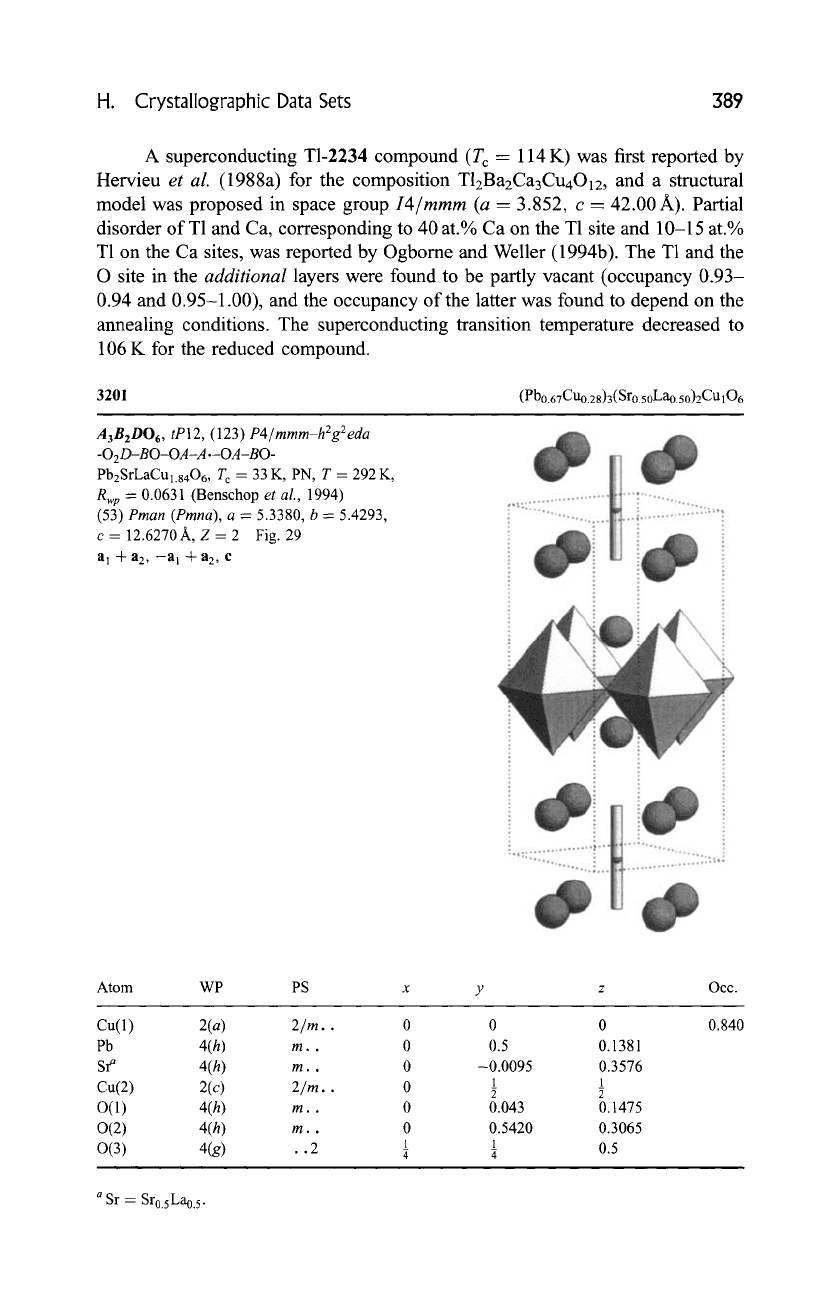
H. Crystallographic Data Sets 389
A superconducting T1-2234 compound (T c = 114 K) was first reported by
Hervieu
et al.
(1988a) for the composition T12Ba2Ca3Cu4012, and a structural
model was proposed in space group
I4/mmm
(a - 3.852, c = 42.00 A). Partial
disorder of T1 and Ca, corresponding to 40 at.% Ca on the T1 site and 10-15 at.%
T1 on the Ca sites, was reported by Ogborne and Weller (1994b). The T1 and the
O site in the
additional
layers were found to be partly vacant (occupancy 0.93-
0.94 and 0.95-1.00), and the occupancy of the latter was found to depend on the
annealing conditions. The superconducting transition temperature decreased to
106 K for the reduced compound.
3201
,,
A3B2DO 6, tP12,
(123)
P4/mmm-h2g2eda
-0 2 D-B O-O A-A .-O A-B O-
Pb2SrLaCul.8406, Tc = 33 K, PN, T - 292 K,
Rwp
= 0.0631
(Benschop
et
al.,
1994)
(53)
Pman (Pmna),
a = 5.3380, b = 5.4293,
c -- 12.6270 A, Z -- 2 Fig. 29
a 1 +a2, -a 1 q-a2, c
(Pbo.
67 C1"10.28 )3 ( S
ro.soLao.5o
)2 Cu 1 O6
Atom WP PS
z Occ.
Cu(1) 2(a)
2/m. . 0
Pb 4(h) m.. 0
Sr a 4(h) m.. 0
Cu(2) 2(c)
2/m . . 0
O(1) 4(h) m.. 0
0(2) 4(h) m.. 0
1
0(3) 4(g) . .2
0
0.5
-0.0095
1
_
2
0.043
0.5420
1
_
4
0
0.1381
0.3576
1
_
2
0.1475
0.3065
0.5
0.840
a
Sr = Sr05Lao. 5.
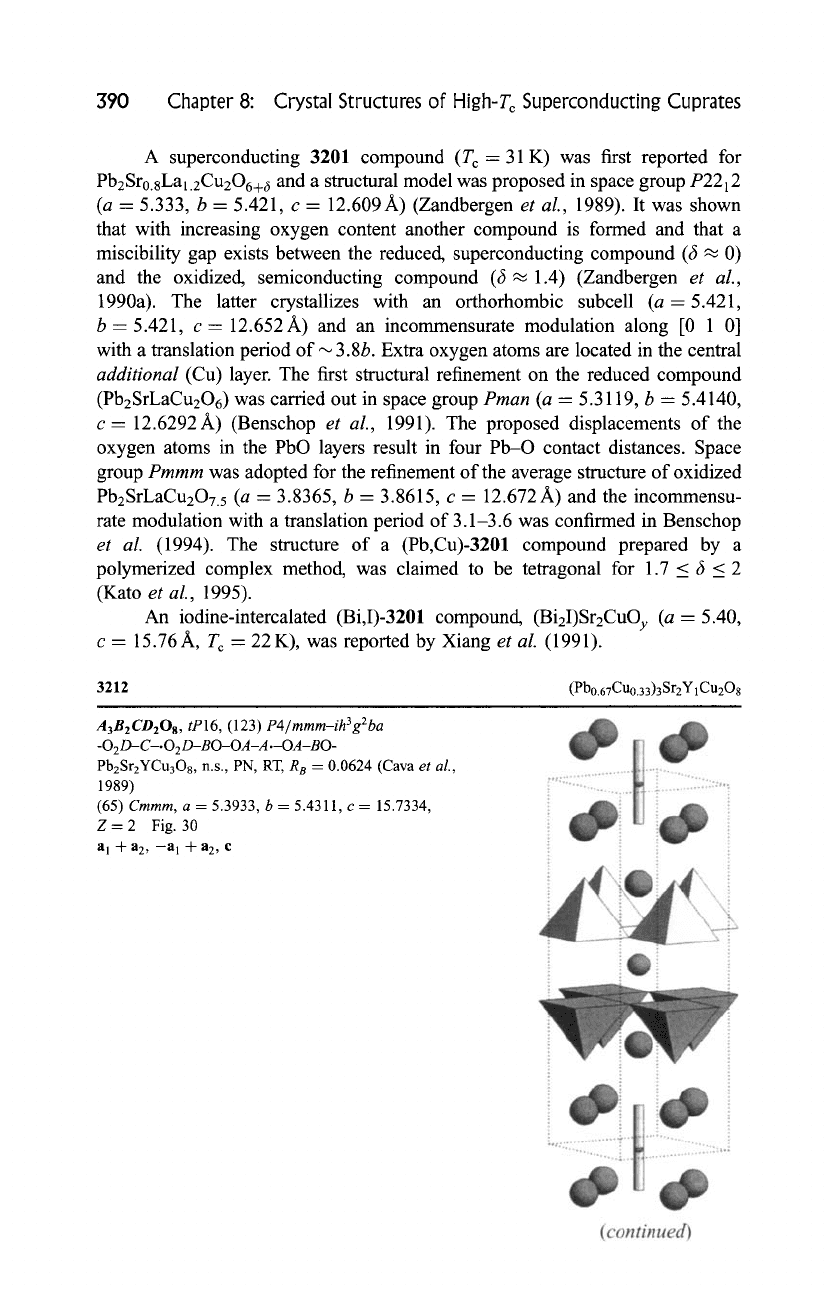
390
Chapter 8: Crystal Structures of High-Tc Superconducting Cuprates
A superconducting 3201 compound (T c --31 K) was first reported for
PbeSro.8Lal.eCu206+ 6 and a structural model was proposed in space group P2212
(a- 5.333, b- 5.421, c- 12.609 A) (Zandbergen
et al.,
1989). It was shown
that with increasing oxygen content another compound is formed and that a
miscibility gap exists between the reduced, superconducting compound (6 -~ 0)
and the oxidized, semiconducting compound (6 ~ 1.4) (Zandbergen
et al.,
1990a). The latter crystallizes with an orthorhombic subcell (a- 5.421,
b- 5.421, c- 12.652A) and an incommensurate modulation along [0 1 0]
with a translation period of ~ 3.8b. Extra oxygen atoms are located in the central
additional
(Cu) layer. The first structural refinement on the reduced compound
(Pb2SrLaCu206) was carried out in space group
Pman (a -
5.3119, b - 5.4140,
c-12.6292A) (Benschop
et al.,
1991). The proposed displacements of the
oxygen atoms in the PbO layers result in four Pb-O contact distances. Space
group
Pmmm
was adopted for the refinement of the average structure of oxidized
Pb2SrLaCu207.5 (a- 3.8365, b- 3.8615, c- 12.672A) and the incommensu-
rate modulation with a translation period of 3.1-3.6 was confirmed in Benschop
et al.
(1994). The structure of a (Pb,Cu)-3201 compound prepared by a
polymerized complex method, was claimed to be tetragonal for 1.7 _< 6 _< 2
(Kato
et al.,
1995).
An iodine-intercalated (Bi,I)-3201 compound, (BizI)SrzCuOy (a- 5.40,
c- 15.76 A, T c - 22 K), was reported by Xiang
et al.
(1991).
3212 (P bo. 67Cu0.33 )3 S r 2 Y 1Cu208
A3B2CD208,
tP16, (123)
P4/mmm-ih3 g2 ba
-02D--C-.O 2D-BO-OA-A.-OA-BO-
Pb2SrzYCu308, n.s., PN, RT, R 8 -- 0.0624 (Cava
et aL,
1989)
(65)
Cmmm,
a = 5.3933, b = 5.4311, c -- 15.7334,
Z - 2 Fig. 30
a 1 +a2, --a 1 +a2, C
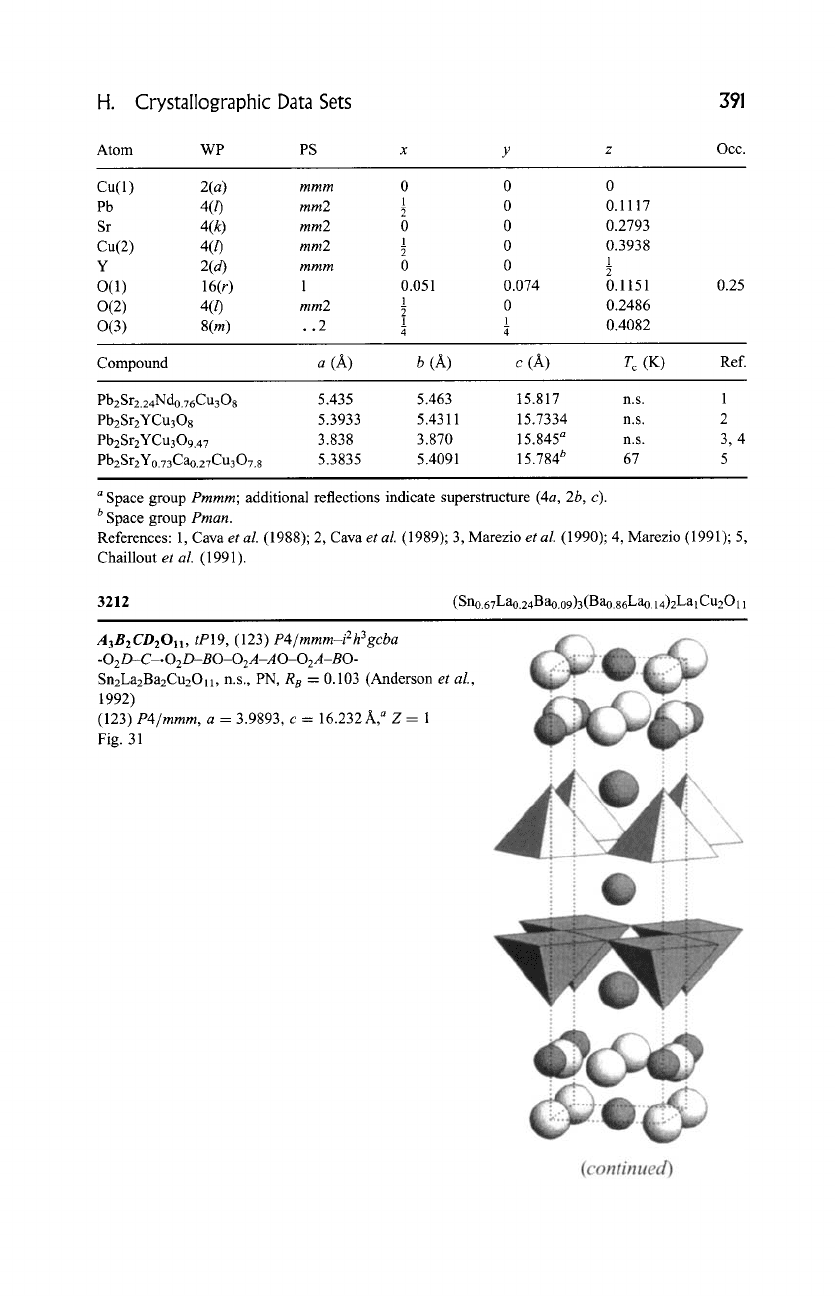
H. Crystallographic Data Sets
391
Atom WP PS x y z Occ.
Cu(1) 2(a)
mmm 0 0 0
1 0
0.1117
Pb 4(/)
mm2
Sr 4(k)
mm2 0 0
0.2793
1 0 0.3938
Cu(2) 4(/)
mm2
1
Y 2(d)
mmm 0 0
O(1) 16(r) 1 0.051 0.074 0.1151
1 0 0.2486
O(2) 4(/)
mm2
1 1 0.4082
0(3) 8(m) . .2 ~
0.25
Compound a (/k) b (A) c (A) T~ (K) Ref.
Pb2Sr2.24Ndo.76Cu308 5.435 5.463 15.817 n.s. 1
Pb2 SrzYCu308 5.3933 5.4311 15.7334 n.s. 2
PbzSrzYCu309.47 3.838 3.870 15.845 a n.s. 3, 4
PbzSrzYo.73Cao.27Cu307.8
5.3835 5.4091 15.784 b 67 5
a
Space group
Pmmm;
additional reflections indicate superstructure (4a, 2b, c).
b Space group
Pman.
References: 1, Cava
et al.
(1988); 2, Cava
et al.
(1989); 3, Marezio
et al.
(1990); 4, Marezio (1991); 5,
Chaillout
et al.
(1991).
3212
(Sno.67Lao.24Bao.o9)3(Bao.86Lao. 14)2Lal Cu2011
A3B2CD2011 ,
tP19, (123)
P4/mmm-i2h3 gcba
-02D-C-.O2D-BO-O2A-A
O-O2A-BO-
SnzLazBazCu2Oll, n.s., PN,
R B
-- 0.103 (Anderson
et aL,
1992)
(123)
P4/mmm,
a = 3.9893, c = 16.232A, a Z -- 1
Fig. 31
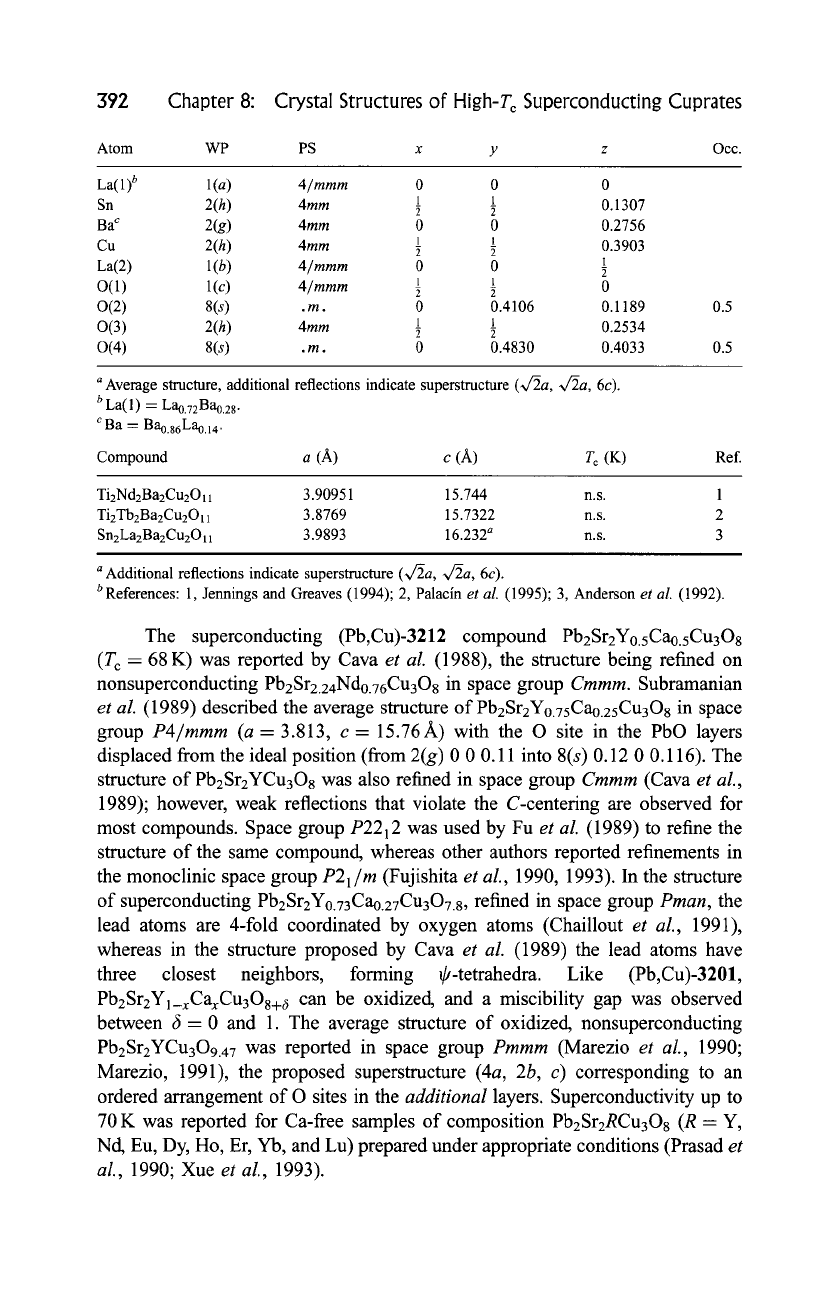
392
Chapter 8: Crystal Structures of High-T o Superconducting Cuprates
Atom WP PS x y z Occ.
La(1)b l(a) 4/mmm
0 0 0
1 1 0.1307
Sn 2(h)
4mm ~
Ba c 2(g)
4mm 0 0
0.2756
1 1 0.3903
Cu 2(h)
4mm ~
1
La(2) l(b)
4/mmm 0 0
1 1 0
O(1) l(c)
4/mmm ~
0(2) 8(s) . m. 0 0.4106 0.1189
1 1 0.2534
0(3) 2(h)
4mm ~
0(4) 8(s) . m. 0 0.4830 0.4033
0.5
0.5
a
Average structure, additional reflections indicate superstructure (~/2a, ,r 6c).
6La(1) = Lao.72Ba0.28.
C Ba = Ba0.86La0.14 .
Compound a (A) c (A) T c (K) Ref.
TizNdzBazCuzO 11 3.90951 15.744 n.s. 1
Ti2 Tb2Ba2Cu2011 3.8769 15.7322 n.s. 2
SnzLazBazCuzO11 3.9893 16.232 a n.s. 3
a
Additional reflections indicate superstructure (~/2a, ~/2a, 6c).
bReferences: 1, Jennings and Greaves (1994); 2, Palacin
et al.
(1995); 3, Anderson
et al.
(1992).
The superconducting (Pb,Cu)-3212 compound Pb2Sr2Yo.5Cao.sCu308
(T c --68 K) was reported by Cava
et aL
(1988), the structure being refined on
nonsuperconducting Pb2Sr2.24Ndo.76Cu308 in space group
Cmmm.
Subramanian
et al. (1989)
described the average structure of Pb2Sr2Yo.75Cao.25Cu308 in space
group
P4/mmm
(a = 3.813, c = 15.76A) with the O site in the PbO layers
displaced from the ideal position (from 2(g) 0 0 0.11 into 8(s) 0.12 0 0.116). The
structure of Pb2Sr2YCu308 was also refined in space group
Cmmm
(Cava
et aL,
1989); however, weak reflections that violate the C-centering are observed for
most compounds. Space group P2212 was used by Fu
et aL
(1989) to refine the
structure of the same compound, whereas other authors reported refinements in
the monoclinic space group
P21/m
(Fujishita
et aL,
1990, 1993). In the structure
of superconducting Pb2Sr2Yo.73Cao.27Cu307.8, refined in space group
Pman,
the
lead atoms are 4-fold coordinated by oxygen atoms (Chaillout
et al.,
1991),
whereas in the structure proposed by Cava
et al.
(1989) the lead atoms have
three closest neighbors, forming ~-tetrahedra. Like (Pb,Cu)-3201,
Pb2Sr2Yl_xCaxCu308+ 6 can be oxidized, and a miscibility gap was observed
between 6- 0 and 1. The average structure of oxidized, nonsuperconducting
Pb2Sr2YCu309.47 was reported in space group
Pmmm
(Marezio
et al.,
1990;
Marezio, 1991), the proposed superstructure (4a, 2b, c) corresponding to an
ordered arrangement of O sites in the
additional
layers. Superconductivity up to
70 K was reported for Ca-free samples of composition Pb2Sr2RCu308 (R = Y,
Nd, Eu, Dy, Ho, Er, Yb, and Lu) prepared under appropriate conditions (Prasad
et
aL,
1990; Xue
et aL,
1993).
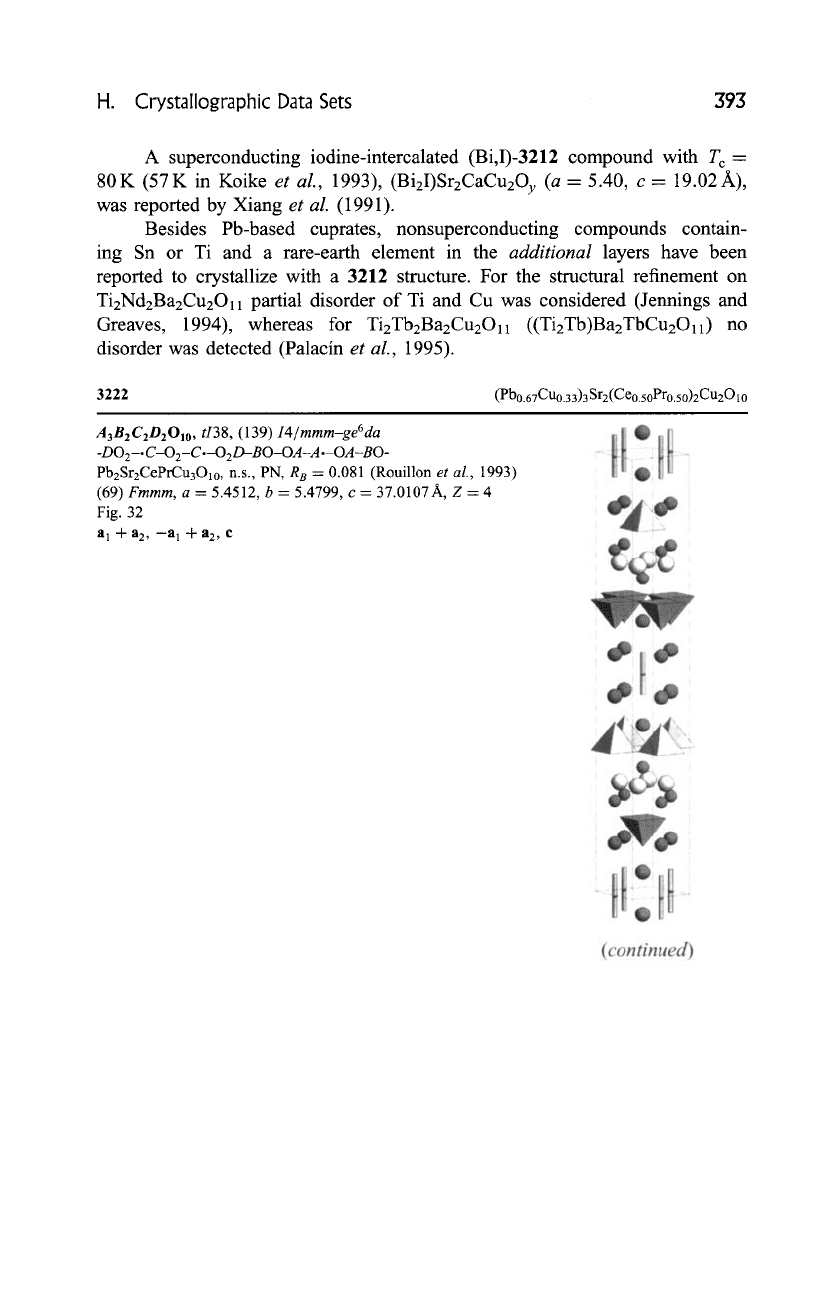
H.
Crystallographic Data Sets 393
A superconducting iodine-intercalated (Bi,I)-3212 compound with T c =
80 K (57K in Koike
et al.,
1993), (BizI)SrzCaCuzOy (a- 5.40, c- 19.02 A),
was reported by Xiang
et al.
(1991).
Besides Pb-based cuprates, nonsuperconducting compounds contain-
ing Sn or Ti and a rare-earth element in the
additional
layers have been
reported to crystallize with a 3212 structure. For the structural refinement on
Ti2Nd2Ba2Cu2011 partial disorder of Ti and Cu was considered (Jennings and
Greaves, 1994), whereas for Ti2Tb2Ba2Cu2Ola ((Ti2Tb)Ba2TbCu2011) no
disorder was detected (Palacin
et al.,
1995).
3222
(Pbo.67Cuo.33)3Sr2(Ceo.soPro.5o)2Cu201o
A3B2C2D201o ,
ti38,
(139)
I4/mmm-ge6da
-002--~ C-02-C o---02
D-BO-OA-A .-OA-BO-
Pb2SrzCePrCu3010, n.s., PN,
R B
-- 0.081 (Rouillon
et al.,
1993)
(69)
Fmmm,
a -- 5.4512, b = 5.4799, c = 37.0107 A, Z = 4
Fig. 32
a 1 -I.-a 2, --a 1 --F a 2, c
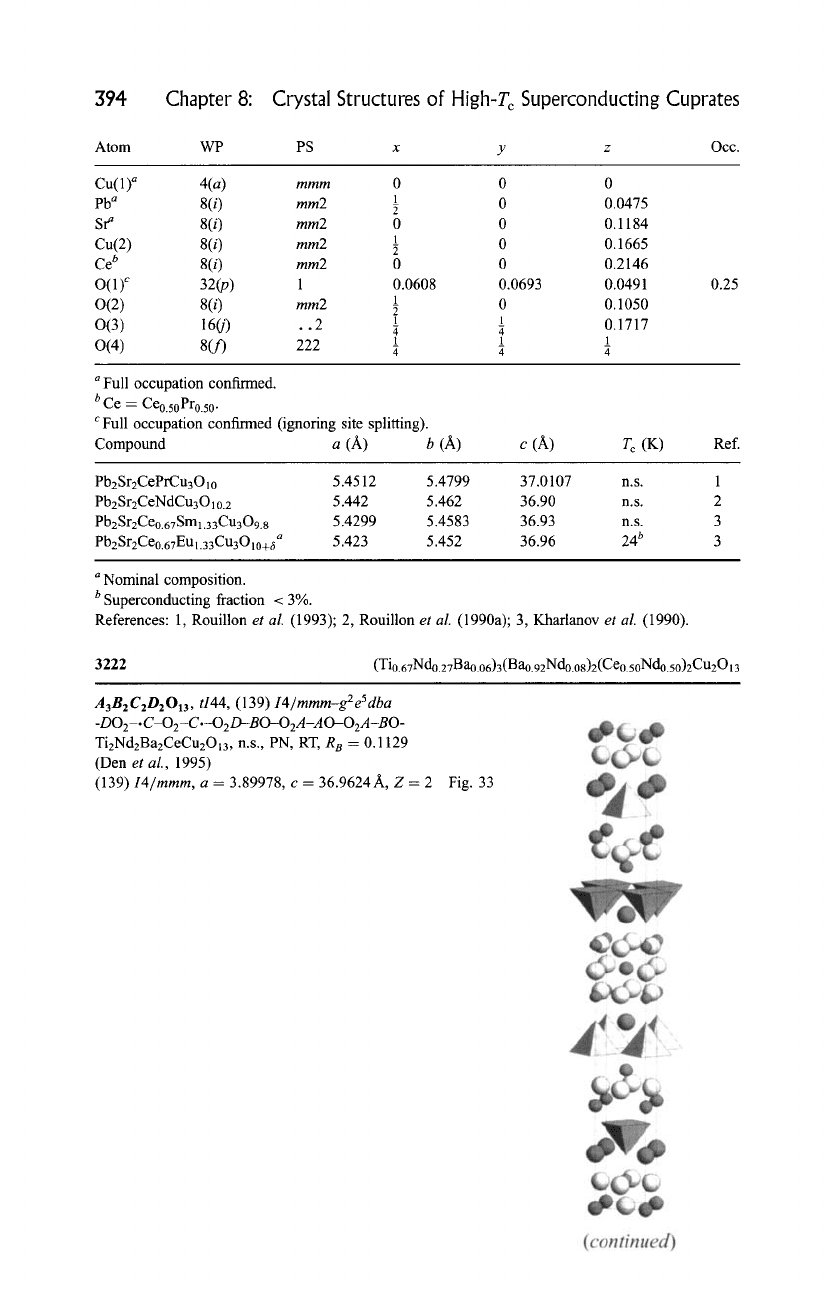
394
Chapter 8: Crystal Structures of High-T~ Superconducting Cuprates
Atom WP PS x y z Occ.
Cu(1) a 4(a)
mmm 0 0 0
1 0 0.0475
Pb a 8(i)
mm2
Sr a 8(i) mm2 0 0 0.1184
1 0 0.1665
Cu(2) 8(i)
mm2
Ce b 8(i) mm2 0 0 0.2146
O(1)c 32(p) 1 0.0608 0.0693 0.0491
1 0 0.1050
O(2) 8(i)
mm2
1 1 0.1717
0(3) 16(/) . .2 ~
1 1 1
0(4) 8(f) 222 ~ ~
0.25
a Full occupation confirmed.
b Ce = Ceo.5oPr0.50.
c Full occupation confirmed (ignoring site splitting).
Compound a (A) b (A)
c (h) T~ (K) Ref.
PbaSrzCePrCu30 lO 5.4512 5.4799 37.0107 n.s.
Pb2Sr2CeNdCu3Olo.2 5.442 5.462 36.90 n.s.
PbzSrzCeo.67Sm1.33Cu309.8 5.4299 5.4583 36.93 n.s.
PbzSrzCeo.67Eu 1.33Cu3010+6
a
5.423 5.452 36.96 24 b
a Nominal composition.
b Superconducting fraction < 3%.
References: 1, Rouillon
et al. (1993); 2, Rouillon et al. (1990a); 3, Kharlanov et al. (1990).
3222
(Tio.67Ndo.27Bao.o6)3(Bao.92Ndo.o8)2(Ceo.5oNdo.5o)2Cu2013
A3B2C2D2013,
ti44, (139) I4/mmm-g2eSdba
-002-~ C-02-C.-02D-BO-O 2A-A0--02A-BO-
TizNdzBazCeCu2013, n.s., PN, RT, R, = 0.1129
(Den
et al., 1995)
(139)
I4/mmm, a = 3.89978, c = 36.9624A, Z = 2 Fig. 33
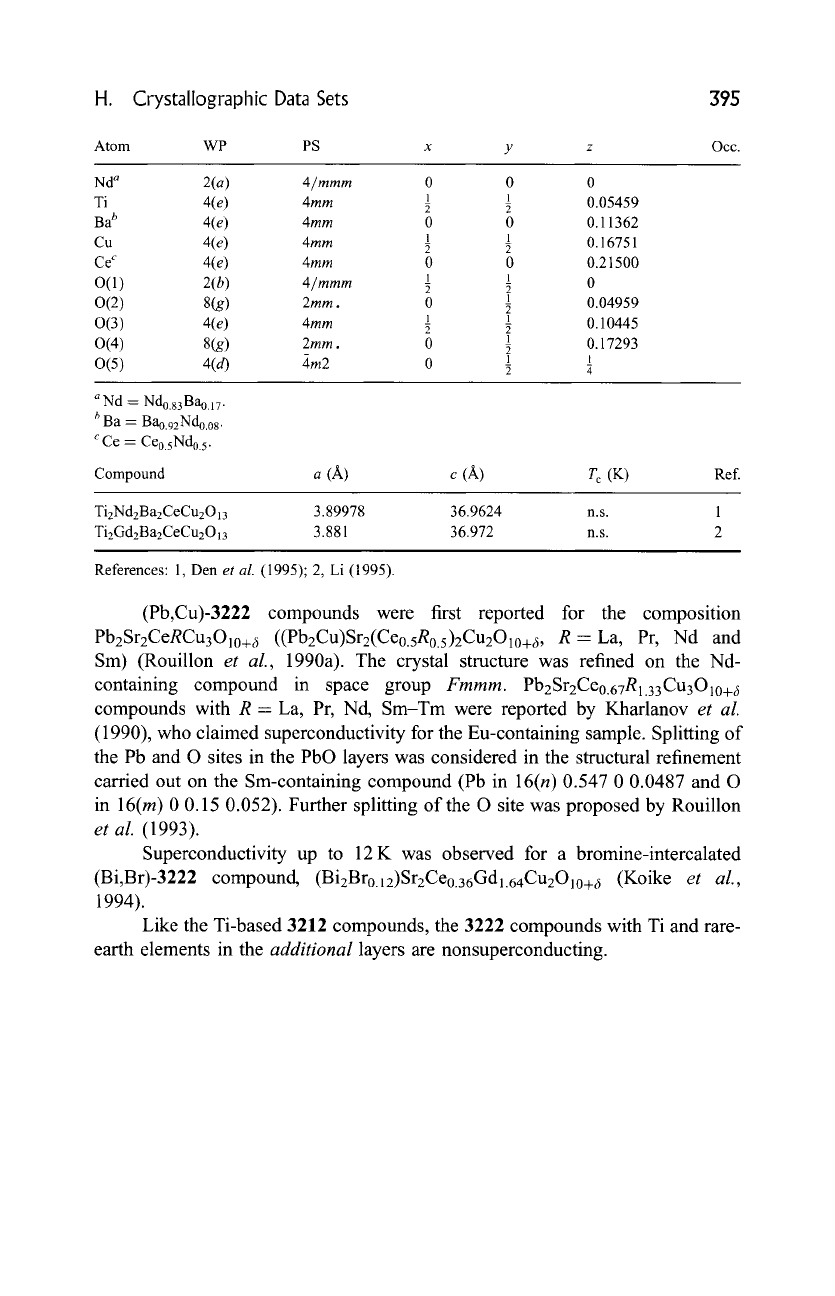
H. Crystallographic Data Sets
395
Atom WP PS
Occ.
Nd a 2(a) 4/mmm 0
1
Ti 4(e) 4mm
Bab 4(e) 4mm 0
1
Cu 4(e) 4mm
CeC 4(e) 4mm 0
1
O(1) 2(b) 4/mmm
0(2) 8(g) 2mm . 0
1
0(3) 4(e) 4mm
0(4) 8(g) 2mm . 0
0(5) 4(d) 4m2 0
0
0.05459
0.11362
0.16751
0.21500
0
0.04959
0.10445
0.17293
1
_
4
aNd = Nd0.83Bao.17.
b Ba = Bao.92Nd0.08.
c Ce = Ce0.sNdo. 5.
Compound a (A) c (A) T c (K) Ref.
Ti2Nd2Ba2CeCu2013 3.89978 36.9624 n.s. 1
Ti2Gd2Ba2CeCu2013 3.881 36.972 n.s. 2
References: 1, Den et al. (1995); 2, Li (1995).
(Pb,Cu)-3222 compounds were first reported for the composition
Pb2Sr2CeRCu3010+6 ((Pb2Cu)Sr2(Ceo.sR0.5)2Cu2010+6, R = La, Pr, Nd and
Sm) (Rouillon
et al.,
1990a). The crystal structure was refined on the Nd-
containing compound in space group
Fmmm.
Pb2Sr2Ceo.67R1.33Cu3010+, 5
compounds with R--La, Pr, Nd, Sm-Tm were reported by Kharlanov
et al.
(1990), who claimed superconductivity for the Eu-containing sample. Splitting of
the Pb and O sites in the PbO layers was considered in the structural refinement
carried out on the Sm-containing compound (Pb in 16(n) 0.547 0 0.0487 and O
in 16(m) 0 0.15 0.052). Further splitting of the O site was proposed by Rouillon
et al.
(1993).
Superconductivity up to 12 K was observed for a bromine-intercalated
(Bi,Br)-3222 compound,
(Bi2Bro.12)Sr2Ceo.36Gdl.64Cu2010+6
(Koike
et al.,
1994).
Like the Ti-based 3212 compounds, the 3222 compounds with Ti and rare-
earth elements in the
additional
layers are nonsuperconducting.
